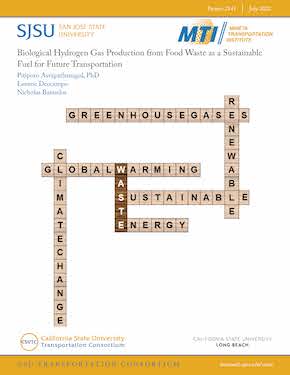- 408-924-7560
- mineta-institute@sjsu.edu
- Donate
Biological Hydrogen Gas Production from Food Waste as a Sustainable Fuel for Future Transportation
In the global search for the right alternative energy sources for a more sustainable future, hydrogen production has stood out as a strong contender. Hydrogen gas (H2) is well-known as one of the cleanest and most sustainable energy sources, one that mainly yields only water vapor as a byproduct. Additionally, H2 generates triple the amount of energy compared to hydrocarbon fuels. H2 can be synthesized from several technologies, but currently only 1% of H2 production is generated from biomass. Biological H2 production generated from anaerobic digestion is a fraction of the 1%. This study aims to enhance biological H2 production from anaerobic digesters by increasing H2 forming microbial abundance using batch experiments. Carbon substrate availability and conversion in the anaerobic processes were achieved by chemical oxygen demand and volatile fatty acids analysis. The capability of the matrix to neutralize acids in the reactors was assessed using alkalinity assay, and ammonium toxicity was monitored by ammonium measurements. H2 content was also investigated throughout the study. The study's results demonstrate two critical outcomes, (i) food waste as substrate yielded the highest H2 gas fraction in biogas compared to other substrates fed (primary sludge, waste activated sludge and mixed sludge with or without food waste), and (ii) under normal operating condition of anaerobic digesters, increasing hydrogen forming bacterial populations, including Clostridium spp., Lactococcus spp. and Lactobacillus spp. did not prolong biological H2 recovery due to H2 being taken up by other bacteria for methane (CH4) formation. Our experiment was operated under the most optimal condition for CH4 formation as suggested by wastewater operational manuals. Therefore, CH4-forming bacteria possessed more advantages than other microbial populations, including H2-forming groups, and rapidly utilized H2 prior to methane synthesis. This study demonstrates H2 energy renewed from food waste anaerobic digestion systems delivers opportunities to maximize California’s cap-and-trade program through zero carbon fuel production and utilization.
PITIPORN ASVAPATHANAGUL, PH.D., P.E.
Dr. Pitiporn Asvapathanagul is an Associate Professor of Environmental Engineering in the Department of Civil Engineering and Construction Engineering Management at California State University, Long Beach. Her research interests are molecular biology for enhancing the understanding of biological wastewater treatment processes, including nitrification, denitrification, bulking, foaming, anaerobic digesters, and aeration diffuser biofilms as well as microbial source tracking, biological hydrogen gas production, biohealing of construction materials, biocementation, and chemical micropollutants coupled with microplastics removal in water and wastewater.
LEANNE DEOCAMPO
Leanne Deocampo is currently a third-year student at California State University, Long Beach working towards a B.S. in Civil Engineering. She aims to specialize in Environmental Engineering and has been assisting Dr. Pitiporn Asvapathanagul with her project titled, “Microbial populations shift during mesophilic and thermophilic anaerobic digestion” since Spring 2021. She is interested in researching the viability of alternative energy sources to improve the environment. Leanne also has experience in construction and works with Kiewit as a Field/Office Engineer Intern.
NICHOLAS BANUELOS
Nicholas Banuelos is an undergraduate student at California State University, Long Beach studying Environmental Science and minoring in Biology. Nicholas’ research interests involve creating cleaner, more efficient wastewater treatments to combat microplastics for a healthier and more sustainable environment in developing communities, but also for wildlife. This ties into his other interests in coastal ecology, studying ways to sustain marine life in drastically changing environments due to climate change. Nicholas has contributed to research involving the biohealing of construction materials, biocementation, and chemical micropollutants (pollutants of emerging concern) coupled with microplastics removal in water and wastewater.
-
Contact Us
San José State University One Washington Square, San Jose, CA 95192 Phone: 408-924-7560 Email: mineta-institute@sjsu.edu






